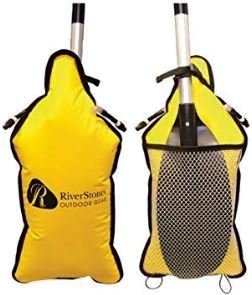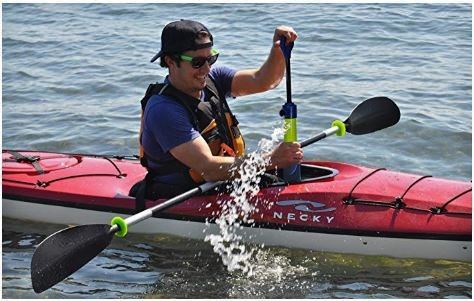Paddling Perspectives: Your Cosmic Paddling Questions Answered
December 2019
by Kent Walters
AUTHOR’S NOTE: This column is intended to be funny, but I sneak in some good information as well.
This month features a heavy emphasis on re-purposed safety equipment.
Photo credit: By Ianaré Sévi - Own work, CC BY-SA 3.0,
https://commons.wikimedia.org/w/index.php?curid=6931045
Q: What are the odds of an alligator taking offensive interest in a paddler?
A: The exact probability depends on some critical variables:
- Is the alligator over 9 feet long, end of snout to tip of tail? (a fully capable apex predator)
- Are there small alligators in the immediate vicinity? (important food source for males, fiercely protected by females)
- Is the alligator male or female? (combine with item 2 above – hungry or protective?)
- What season is it? (in spring - breeding time - males get very territorial; in summer – nesting time, females are fiercely protective)
- How close are you to the animal? (is it changing its behavior because of your presence?)
- Are you going toward, away from, or sideways to the alligator in question?
- Is the alligator moving toward, away from, or sideways to you?
- Are you and the alligator on land or in/on water? (alligators can “high walk” at 30 mph)
Considering the above factors, if in spring time there is a 12-foot male alligator in his territory, whether or not he holds title to said territory, with no small alligators hanging around, and he is 10 feet from you on land and moving fast toward you with his mouth open, I’d say the odds are pretty favorable (about 100%) that he is offensively interested in you, and, by the way, you should have been contemplating near-term action some time ago.
Photo credit: By Christy Long
Q: What are those brightly colored bags with rope I see on some kayaks and in some canoes?
A: When a paddler disobeys the prime directive (This Side Up), he/she gets wet. The rope is for hanging up the wet clothes at the next break or lunch stop or camp site to minimize the effects of hypothermia, even though the hypothermic punishment is deserved for disobedience.
NOTE 1: You don’t need one of these rope bags on a Bruce Bodson trip because there are no breaks. Good luck with your hypothermia.
NOTE 2: The ropes in these bags are especially robust to survive multiple dryings after multiple dunkings, and are so strong that they can even be used to drag your boat up a bank to get it up to a campsite, if need be. There are even times when they have been used to rescue a capsized swimming paddler in swift water.


A: Some paddles are heavier than water, so if you accidentally (or on purpose for that matter) drop one in the water, especially in the Brazos, it will disappear and you will quite literally be up a creek without a paddle. So a properly installed paddle float will keep at least a part of the paddle on top of the water where you or one of your paddling buddies can see it to retrieve it.
Paddling with a paddle float also makes it easy to pull the paddle up out of the water at the end of your stroke because of its additional buoyancy. You lose some efficiency on the “catch” (putting your paddle in the water) and stroke because the float changes the shape of the edge and face of your paddle, and it is more susceptible to wind resistance, but the buoyancy at the end of the stroke makes up for it.
Paddle floats come in two basic types: foam and inflatable. Either will float any paddle, but the foam ones are more reliable because they will not lose their flotation power or void the warranty if a thorn or gar or water moccasin or 12-foot alligator punctures them, and they won’t get ripped open on passing vegetation or rocks. Of course, if a 12-foot alligator is ripping open your inflatable paddle float, you would not be too worried about the voided warranty on the paddle float.
An additional use for the paddle float is as a way to leverage yourself back into your kayak after disobeying the prime directive, though this procedure does not come as naturally as paddling with the float.


Q: I have attached a couple of pictures of a piece of equipment someone was using near me on a recent paddling trip. What is it?
A: I have posted the photos you sent up above your question so the rest of my extensive reading audience can see what you are talking about. This is a very useful piece of equipment. It is a combination water filter and drinking fountain – a kind of upgraded “Life Straw”. You’ll notice in the action shot you took of the guy in the red kayak, he is pumping water into the filter on both the up and down strokes, and it is exiting the spout on both up and down strokes. In the close-up photo, you can almost see the barbs on the spigot. Please send a sharper photo next time. This makes it possible to attach some tubing so you can get the water to go directly into your mouth, like the Camelback hydration systems, but on steroids, so to speak. This was designed for those crazy Water Safari contestants who need to get a lot of water in them without wasting any time.
A secondary use for this is to empty water out of your boat if some happens to get in, but a coffee can or cut-off bleach bottle with a sponge works just as well and is a lot cheaper.

Q: What was “off” about the cute girl paddling the canoe on the cover of the 2000 edition of “Rivers and Rapids”?
A: The position of the blade, as indicated by the horizontal alignment of the grip of the paddle, combined with the 45º angle of the shaft, indicate a draw that should be getting her full attention. The guy behind her seems equally unfocused, and is, in fact, out of focus. By the way, she does not need a paddle float on her wooden paddle, because it will float by itself.
IT HAS BEEN SAID THAT . . .
OVERHEARD . . .
She asked me to tell her those three words that every girl wants to hear, so I said;
“Let’s go kayaking!”
 |
| The author, Kent Walters |